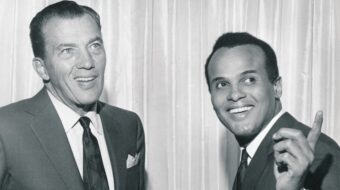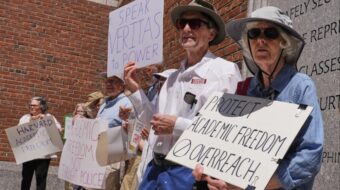
Progressive radio, while certainly not perfect, has generally been an oasis of truth in a hailstorm of right-wing crap. My favorite has been Thom Hartmann’s program. He isn’t a screamer, always is prepared, has done his research, tends to center his discussion on what is good for regular working people and treats his callers with respect. However, in the recent period, when speaking about the epidemic of racist police murders of African Americans, he has resurrected the concept of “white skin privilege,” a long discredited political idea, one I hadn’t heard since the 1960s-70s.
Some might say, “Well, of course! White folks aren’t the victims of racism, they have privilege!”
However, the concept of “white skin privilege” isn’t a description of slavery and the racism that has historically been central to the foundation and development of our nation. “White skin privilege” is a political concept that affects how forces within our nation’s multiracial working class relate to, work with, each other and how we jointly work to defeat racism. The application of this concept in real life divides, rather than unites, working folks. At its base “white skin privilege” tells white working folks that they do actually benefit from racism. As well, the message to African Americans and other victims of racism is that they have no potential allies in white working folks. Instead it says that “white people,” not the mainly white capitalist ruling class, are the originators and beneficiaries of racism. The message is that racism is actually in the interests of white working people and that they have no interests in its elimination. It is a message of isolation and certain defeat for the victims of racism.
For proof of the existence of “white skin privilege,” Hartmann has cited composite income numbers for racial categories of people in our nation, which include wealthy as well as poor and working folks, to “show that white people gain economically from racism.” When a person calls Hartmann’s program, Hartmann’s response has generally been that he “is just a poor white person that doesn’t know anything of the experience of African Americans.”
This patronizing attitude is the opposite of a working class, Marxist, approach, which holds that, while racism absolutely does great harm to African Americans, it also ultimately harms white workers as well, splitting working people and strengthening only the overwhelmingly white corporate ruling class. The working class approach holds that, because it is white folks who are infected by racism, white workers have a responsibility to help lead in the fight against racism. A working class approach, further, holds that the working class is multiracial, only artificially divided, and that overcoming racism is a necessity if this multinational working class is to make any gains. this approach has been proven by history to be successful in combating racism, winning gains for all working people.
At its heart, the concept of “white skin privilege” is actually the oldest, most effective weapon, the one most used historically by the ideologues of the racist ruling class. From the days of slavery until the present, their most relied upon narrative when speaking to white working folks has always been: “At least you are white!”
It is this horrible, destructive narrative that was used to get hundreds of thousands of poor and working class white Southerners to fight for, lay their lives down for, the slave-holding ruling class of the old Confederacy.
It is that narrative that has always been at the very center of racist “talking points,” always with the clear, and false, political point that the basic interests of African American and white working folks are not the same.
Our nation’s history is not only the history of slavery, racism and division, but also the history of struggles to defeat them, of both white and African-American people. Another part of the false ruling class narrative, that of the “happy slave,” is put to bed by the true historical record of slave rebellions, at times when defeat and ultimate death could be the only outcome. However, the struggle that finally defeated slavery was peopled with thousands of heroic, courageous white, as well as African American, fighters for democracy. Without William Lloyd Garrison, the Tappan brothers and John Brown, not to mention Abraham Lincoln and the Union Army, this struggle could not have been won.
The fight for the abolition of slavery, as well, gave birth to the modern women’s movement in our nation. Elizabeth Cady Stanton, Susan B. Anthony and thousands who later became the core of our nation’s fight for women’s rights were able to be active in the abolitionist movement at a time when women were denied any voice in politics.
The organizing of the unorganized in the 1930s was only able to occur when the great CIO slogan “Black and white, unite and fight,” was put into practice. There is no question the civil rights movement of the 1960s could never have won the great gains it did were it not a multiracial movement.
While racism is at the very core of our entire nation’s history, it is in the old South, the former Confederacy, where African American slavery was ingrained, that this vile racist ideology has historically had its strongest political base. If “white privilege” was in reality a correct historical concept, then this region would be where white working people have the best working conditions, the best schools, the most elected representatives, the strongest retirement security, etc. The reality is the opposite! For both African American and white working folks, this region, where the racist division is most historically and deeply ingrained, is also the area of lowest wages for all workers, the least unionization and the highest level of folks without health care, the poorest schools and the lowest levels of retirement security. It is, in fact, the exact opposite of what would be (for white workers) if “white skin privilege” were a real economic/political reality.
In truth, “white skin privilege” is a key racist concept that our nation’s ruling class has used to divide and weaken our multinational working class. And history has shown that the mainly white ruling class is the only winner when we are divided.
This past week, we were informed of the loss of the great African American leader of the Steelworkers union, Oliver Montgomery. This bad news brought to mind some of the tough struggles that he helped lead, and what they say about the issue at hand.
Oliver Montgomery was one of the leaders of the struggle of African American and progressive steelworkers to break the racist practice of the basic steel corporations of only hiring and keeping minority steelworkers in the coke plant and blast furnace, the toughest, dirtiest, most dangerous areas.
In the early 1970s, the Ad Hoc Committee of Concerned Steelworkers, the Youngstown-based Black Caucus led by Jimmy Davis, had filed a lawsuit in federal court urging the court to break this racist corporate hiring/staffing policy and set up a new, fairer system. Hundreds of African American steelworkers were plaintiffs in the suit. Oliver Montgomery was part of the suit, but also saw the need to win the fight politically to win all steelworkers to support it. Along with the National Steelworkers Rank & File Committee (NSWRFC), the left-led multiracial reform group in the USWA, with George Edwards, Juan Chacon and Butch Henderson co-chairs, Montgomery helped launch a campaign to show how white as well as African American workers would win if Black workers won their legal fight. Working with Montgomery, the NSWRFC filed an amicus brief in favor of the suit and threw itself into a mass campaign to win the whole union, especially white workers, to support this fight.
In 1974, a federal court in Fairfield, Alabama, ruled, in a sweeping decision, that African American workers had suffered historic discrimination, being hired and kept in the worst, most physically demanding and dangerous jobs, and denied rights to transfer to better positions in other areas of the mill. The ruling also stated that these minority workers had been denied the most favored craft positions. The USW and the basic steel companies, under pressure from the federal court, then agreed to a historic consent decree, to apply the decision to the entire steel industry.
The consent decree paid back pay to many African American workers who’d been denied transfers/promotions, set up a job posting procedure that gave all workers the right to transfer to jobs in other areas, and opened new apprenticeship positions to highly sought after craft positions, with African American, women and Latino workers given preference.
However, for many white workers, the immediate response was negative. Many white workers, influenced by racist ideas, packed union meetings to attack the decree, feeling they had “lost rights.” Outright racist organizations kicked in also, funding court cases, citing so-called “reverse racism.” Their position was that since minority workers had won rights, this supposedly denied rights to white workers. These included the Weber, then later Bakke, cases calling for the consent decree’s reversal. Oliver Montgomery was key to calling a series of multiracial meetings of progressive steelworkers for the purpose of defending the hard-won gains of African American workers. Central to the campaign that emerged from these gatherings was the concepts that:
● The gains won in the consent decree were a real blow to historic corporate racism, winning gains due minority workers.
● However, these gains not only benefited minority workers, but helped all steelworkers and could be the base to greatly strengthen unity of all steelworkers.
● The consent decree and its gains could not be defended only by African American workers. A campaign had to be launched to win white workers also to its defense.
● Without this unity campaign, corporate-funded racist attacks could succeed in rolling back our gains, ultimately harming all workers and the USWA.
The National Steelworkers Rank & File Committee, with George Edwards, a white steelworker, taking the lead and working closely with Oliver Montgomery, mobilized progressive workers and union leaders and worked with other union reform groups to fight to defend the gains won in the consent decree. To do so they were able to show numerous ways that the fight against racist practices, and the consent decree, concretely helped all workers and that, without a fight to defend these gains, again, all workers, not only African American workers, would lose significant and hard-won rights.
Using research Edwards had done, they were able to show that the steel corporations had kept pay rates artificially low on coke plant, blast furnace and others of the “worst” jobs (but also the most important jobs) which the companies had filled exclusively by minority workers. This racist practice had not only kept those jobs poorly paid, but had also been a drag on all other job pay rates, harming all workers. The consent decree laid the base for defeating this, winning raises for all steelworkers.
As well, reform forces were able to highlight how the consent decree’s establishment of a procedure for posting of jobs plant-wide helped all workers. Previously workers were kept by management in the same area they were hired into. While the fight was against racist company hiring/staffing practices, this new procedure democratized the workplace and created new transfer and staffing rights for all workers. These new rights, won through difficult struggle against corporate racism, would disappear if the consent decree was rolled back.
While there were arguments over filling the newly opened up craft positions, the reform forces were able to show that the companies had stopped filling craft jobs from within, only hiring from the street when they filled a craft job. The creation of the new craft positions was another gain from the struggle for African American job rights, without which there would be no new craft jobs for anyone to bid on. Putting the fight in this context, it became possible to show white workers that African American workers had long fought for these positions and been unjustly denied, therefore they were rightfully entitled to fill them first. Latino and women workers also were brought into this mix, and also won new rights due to this struggle.
The upshot of this fight was that the very same union halls where some workers were so adamant that the consent decree needed to be killed, would have almost literally killed anyone coming there just a few months later if that was the message they brought. Steelworkers, in the great majority, were quickly won over to seeing how the decree, and the struggle to win it, was in all of their interests. This outcome was not possible without an understanding that our working class is one multiracial class and that racist company practices harm us all. Only a united struggle against racism, with white workers playing a significant role, could win gains for all. Had Oliver Montgomery, George Edwards and other fighters for justice not taken this fight up as central to progress for our entire working class, had progressive unionists been influenced by the poisonous concept of “white skin privilege,” there is no way white workers could have been effectively mobilized to defend the gains won in the fight for African American workers rights, a fight that ultimately won new rights for all workers.
Someone much smarter than me once said that “there are no new ideological fights, only the same old ones we keep re-fighting and calling by new names.” I believe we can only win them when we learn from the struggles of working folks that fought them before us.
As we see the rise of a new, powerful movement for justice, for Black Lives Matter, against mass incarceration and racism, it is important that we look at the lessons of past historic victories and how we got here. Oliver Montgomery, George Edwards and those other real heroes upon whose shoulders we now stand helped us learn not just how to fight, but ultimately how we can beat the entrenched power of the corporations. We cannot allow a new generation to be sacrificed because they don’t have every tool that has to be used in the struggle against racism, for unity and justice!
Photo: Steelworkers at a Save Our Steel Jobs rally, May 6, 2014, Lorain, Ohio. United Steelworkers/Flickr










